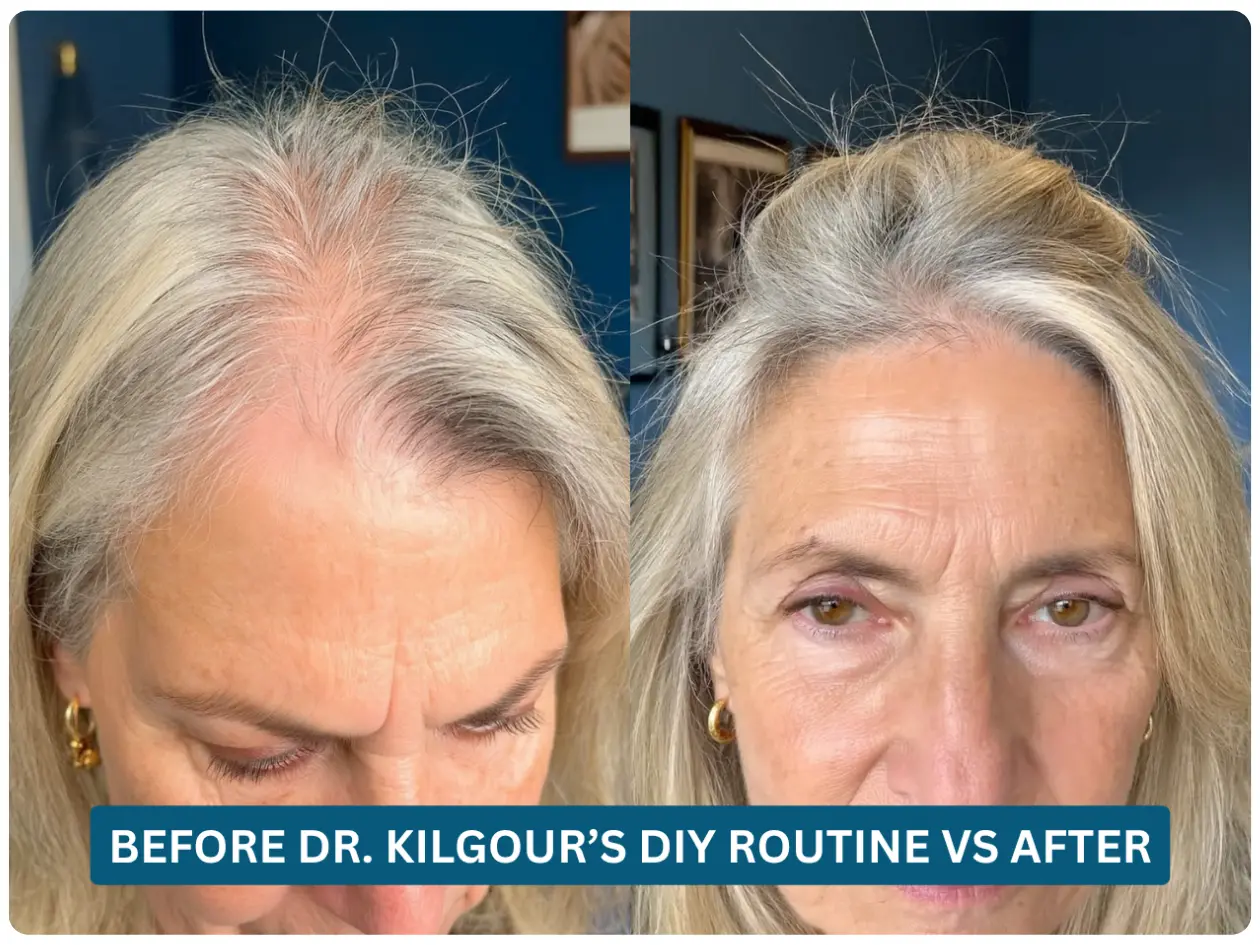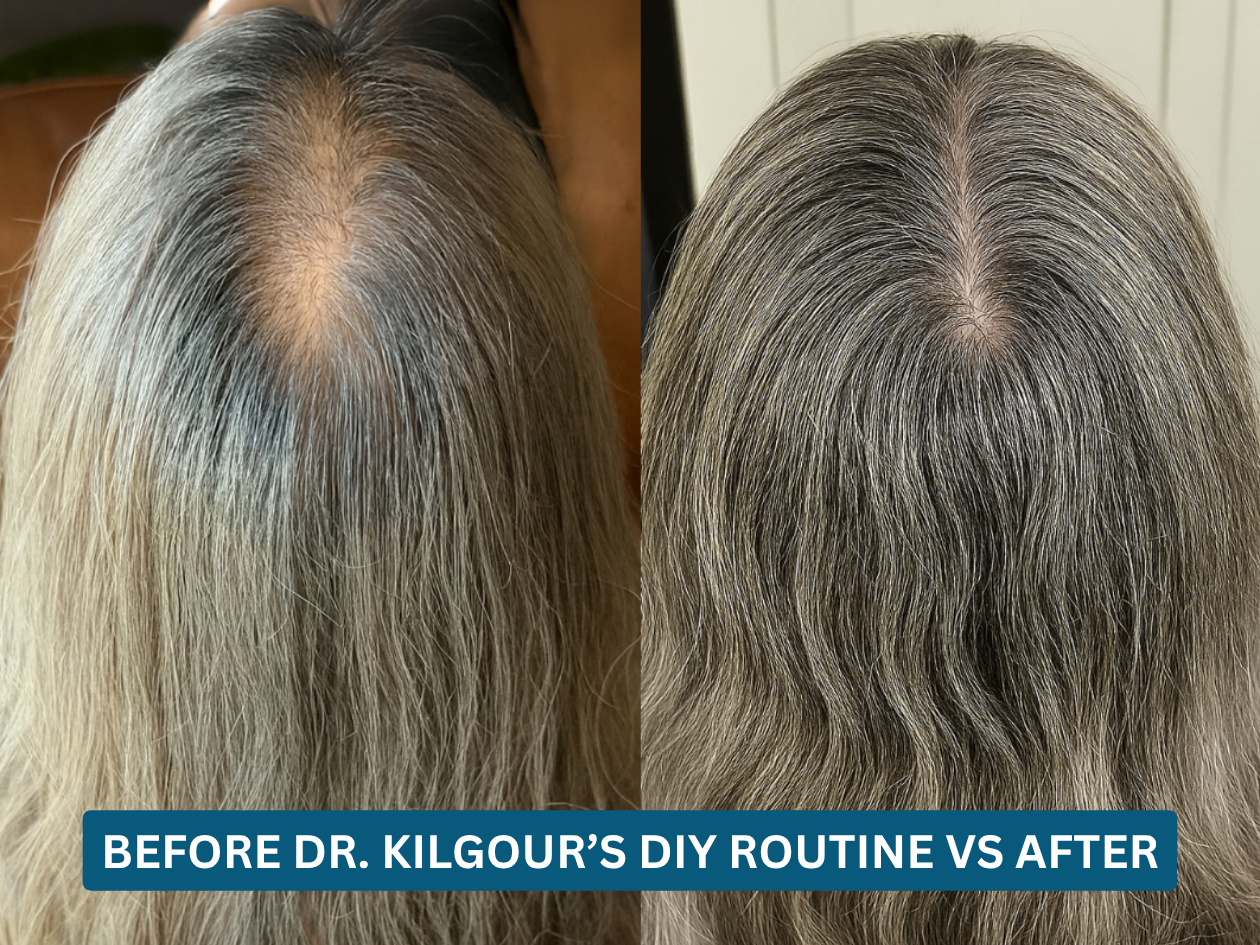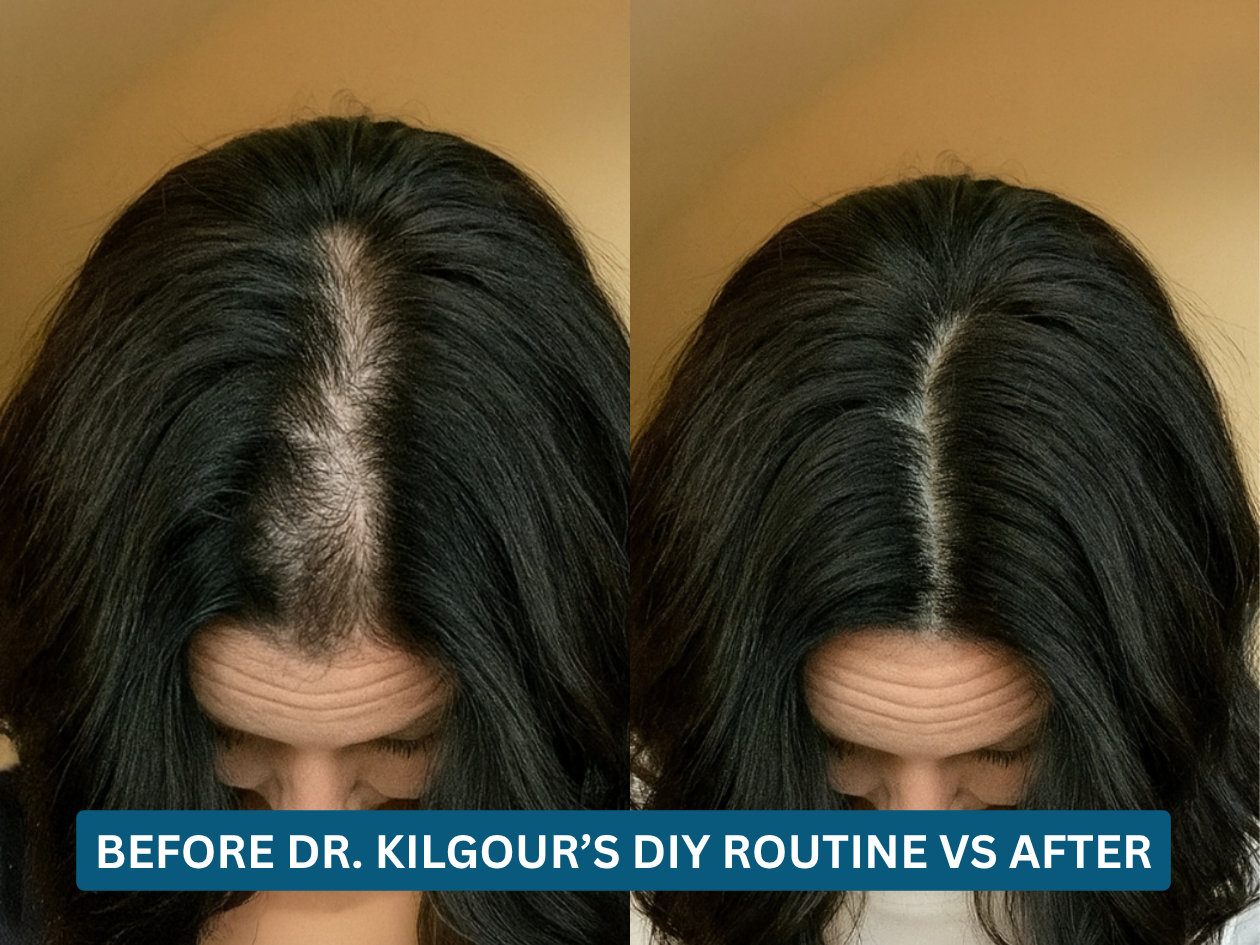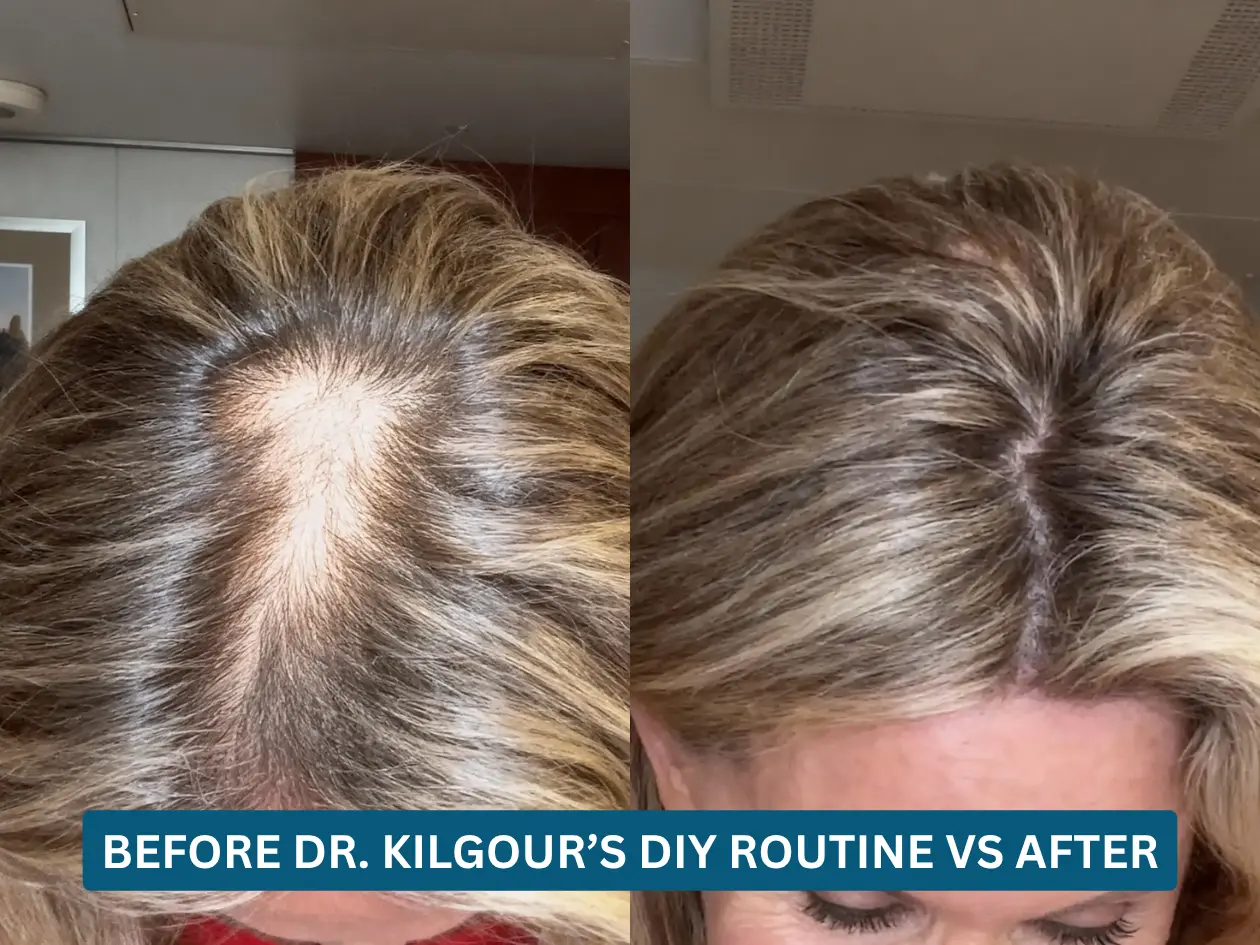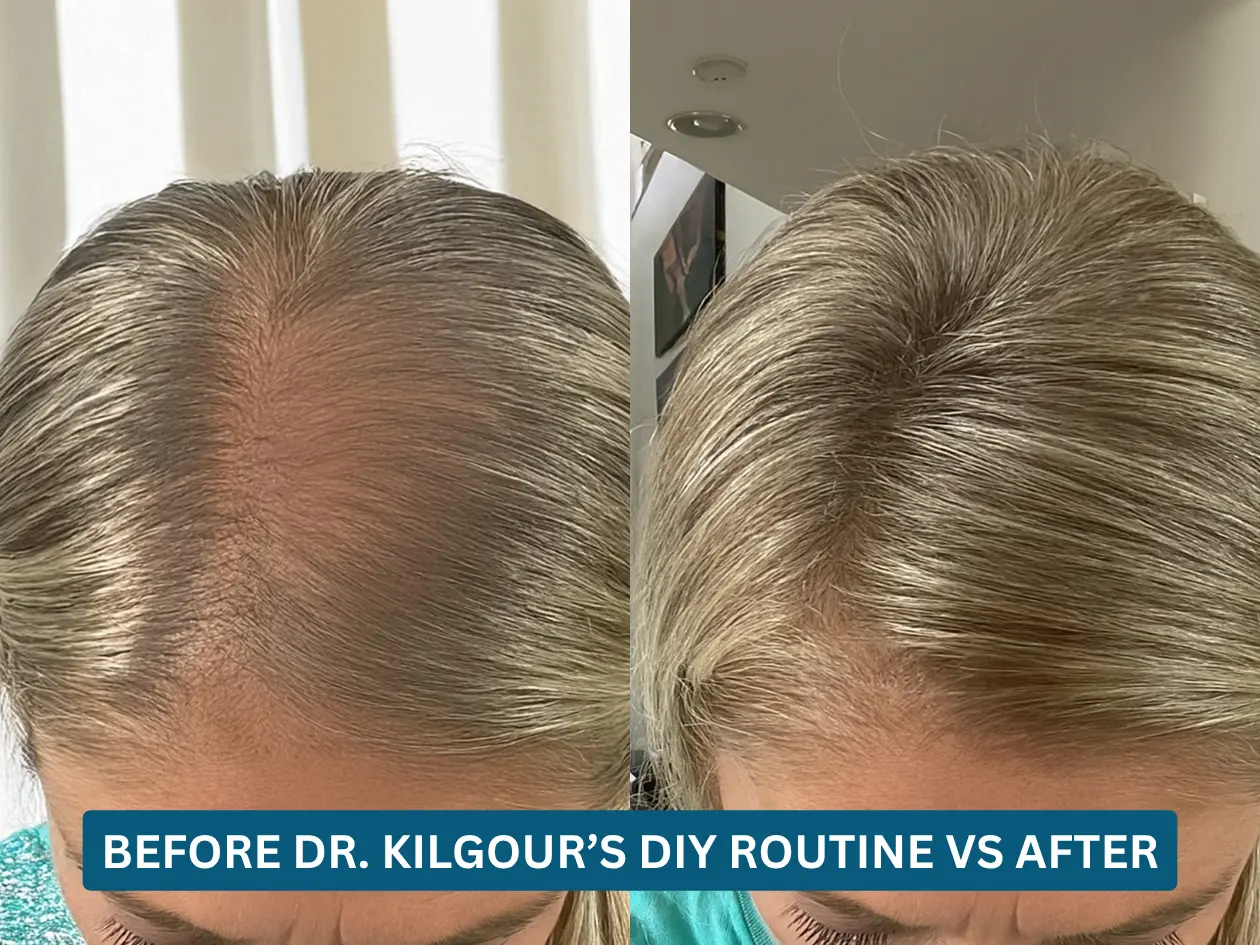
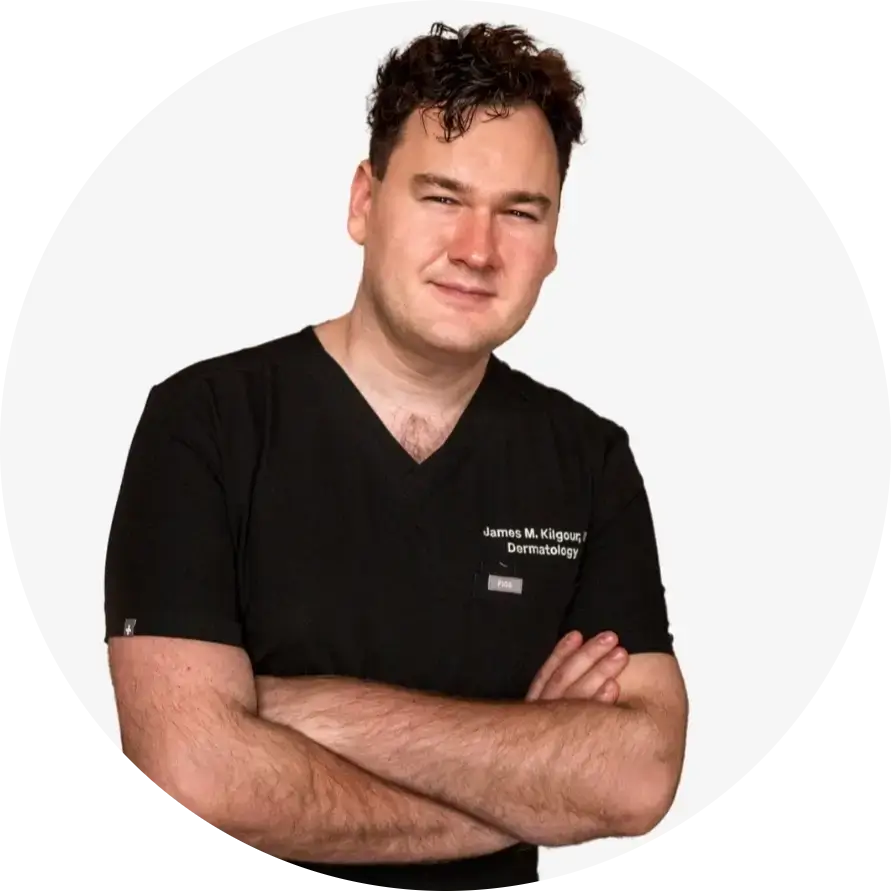
Dr. James Kilgour
Stanford-Trained, Board-
Certified Dermatologist
Stanford Dermatologist Watched His Mother Go Bald. Then He Did This (Viral Before and After)

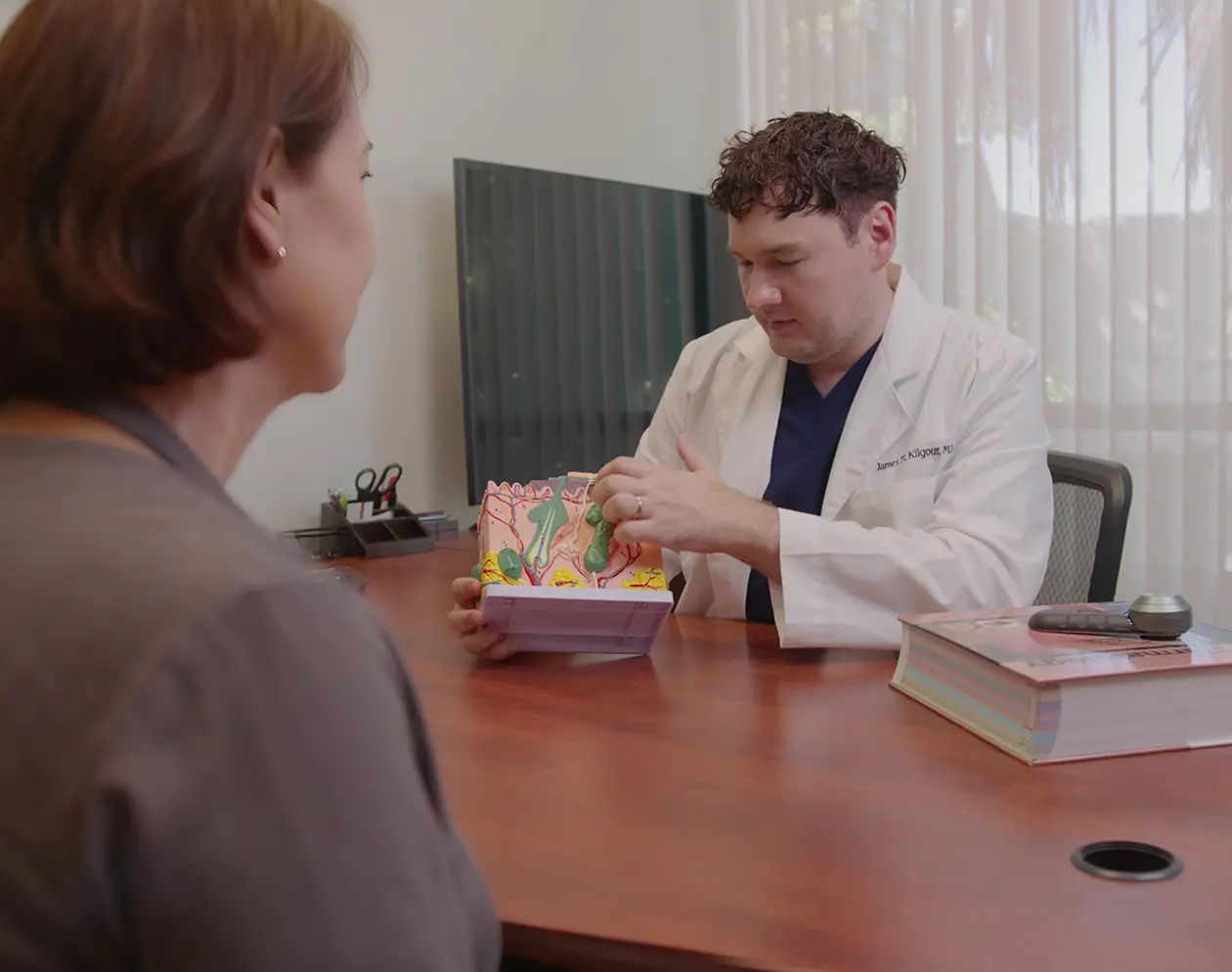
A Stanford-trained dermatologist tested every hair loss treatment on his own mother during menopause. Here's his honest review of what worked, what backfired, and the surprising DIY routine that finally restored her hair.
As a Stanford-trained dermatologist, I had access to every treatment available. So when my mother came to me in tears in 2020, I tried them all on her.
I'm Dr. James Kilgour, and before I was a doctor, I was a son watching his vibrant mother disappear before my eyes.
It started subtly after menopause. A few more strands on her pillow. A ponytail that felt thinner. A part that suddenly looked wider.
Within months, she went from subtle thinning to barely recognizing herself in the mirror.
She stopped going out with friends. Stopped taking photos. She'd spend hours trying to cover the thinning areas.
I tried everything on her. Minoxidil. Biotin supplements. Rosemary oil. Castor oil. Every treatment dermatologists recommend.
Most did nothing. Some made things worse.
What I discovered while desperately trying to save her hair would prove that everything we've been told about menopause hair loss is wrong.
Let me walk you through each treatment so you can avoid the mistakes she made.

Who is Dr. James Kilgour?
Dr. James Kilgour is a Stanford-trained dermatologist who graduated with honors from Cardiff University School of Medicine and completed prestigious fellowships at Oxford and Stanford. He currently practices at Golden State Dermatology, specializing in scalp conditions and hair loss disorders.
His path to this specialization became personal when his own mother started losing her hair and every standard treatment failed her.
"As both her son and a dermatologist with access to every treatment available, I couldn't accept there was nothing I could do," Dr. Kilgour recalls.
That personal mission led to a breakthrough in understanding scalp tissue aging. His DIY method is now recommended by over 700 physicians nationwide and has helped over 40,000 women restore their hair.
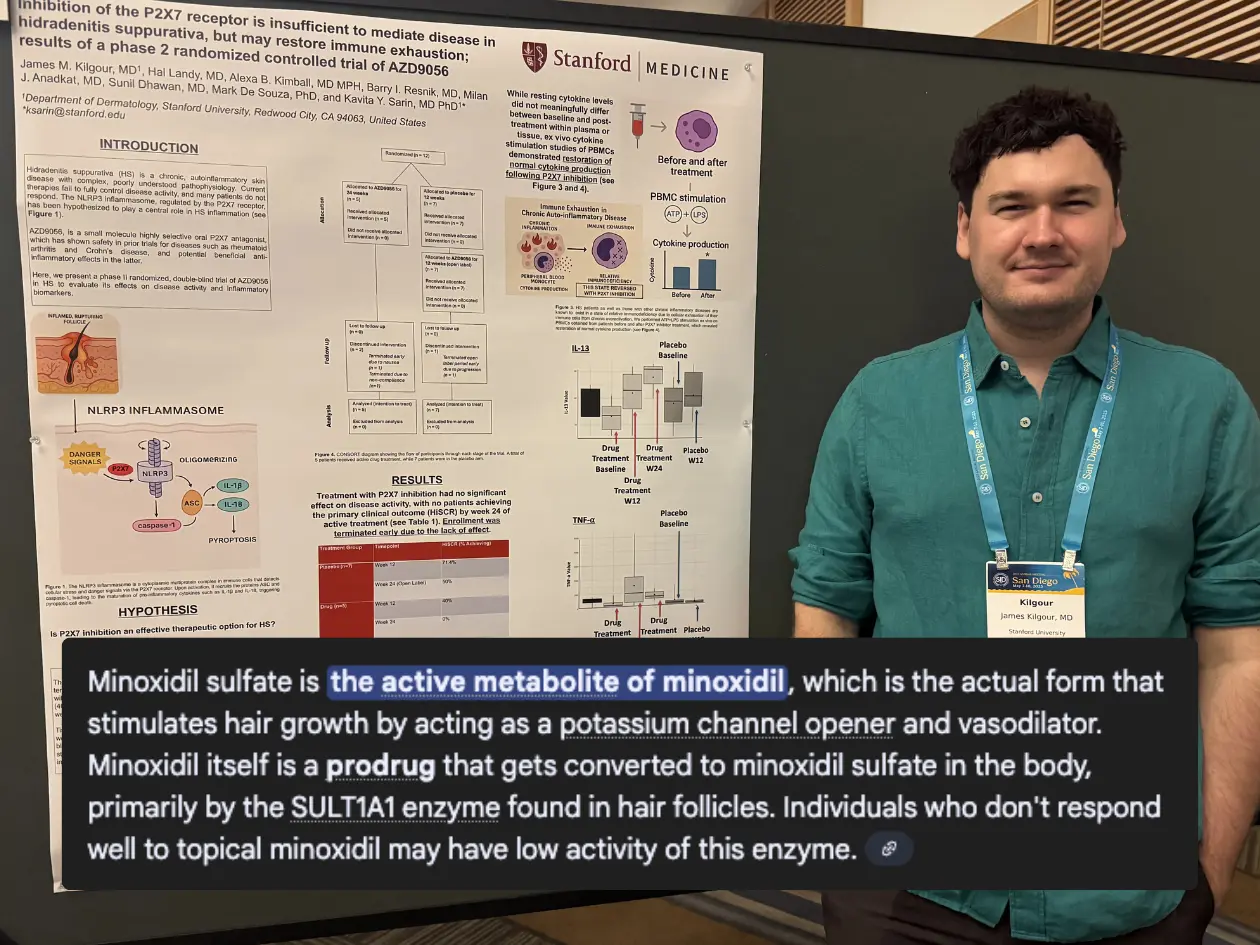
1. Minoxidil: Have You Ever Heard of Sulfotransferase?
Minoxidil was the first thing we tried. It's the gold standard, recommended by every dermatologist.
Within weeks, my mother's scalp was burning. The shedding got worse, not better. She'd wake up with clumps on her pillow.
After six months of religiously applying it twice daily, there were no results. Just more hair loss and an irritated, inflamed scalp.
I was confused. I'd prescribed this to hundreds of patients. Why wasn't it working for my own mother?
That's when I dove into the research and found something that changed everything.
Here's what they don't tell you: Minoxidil itself is inactive. It needs a specific enzyme called sulfotransferase to convert it into something that actually works.
Up to 70% of menopausal women don't have enough of this enzyme anymore.
Why? Because menopause makes your scalp age 10 times faster than your face. By 50, you can have a 90-year-old scalp. And aging scalps lose the ability to produce this critical enzyme.
My mother's scalp couldn't activate the minoxidil. She was just irritating already-fragile tissue, forcing shedding without the biological mechanism to produce regrowth.
She was making things worse, not better.
My recommendation: I still prescribe minoxidil, but only for younger women with pattern hair loss or for men. I would never recommend it for menopausal women or postpartum mothers whose scalps have aged too rapidly to produce the enzyme needed to activate it.
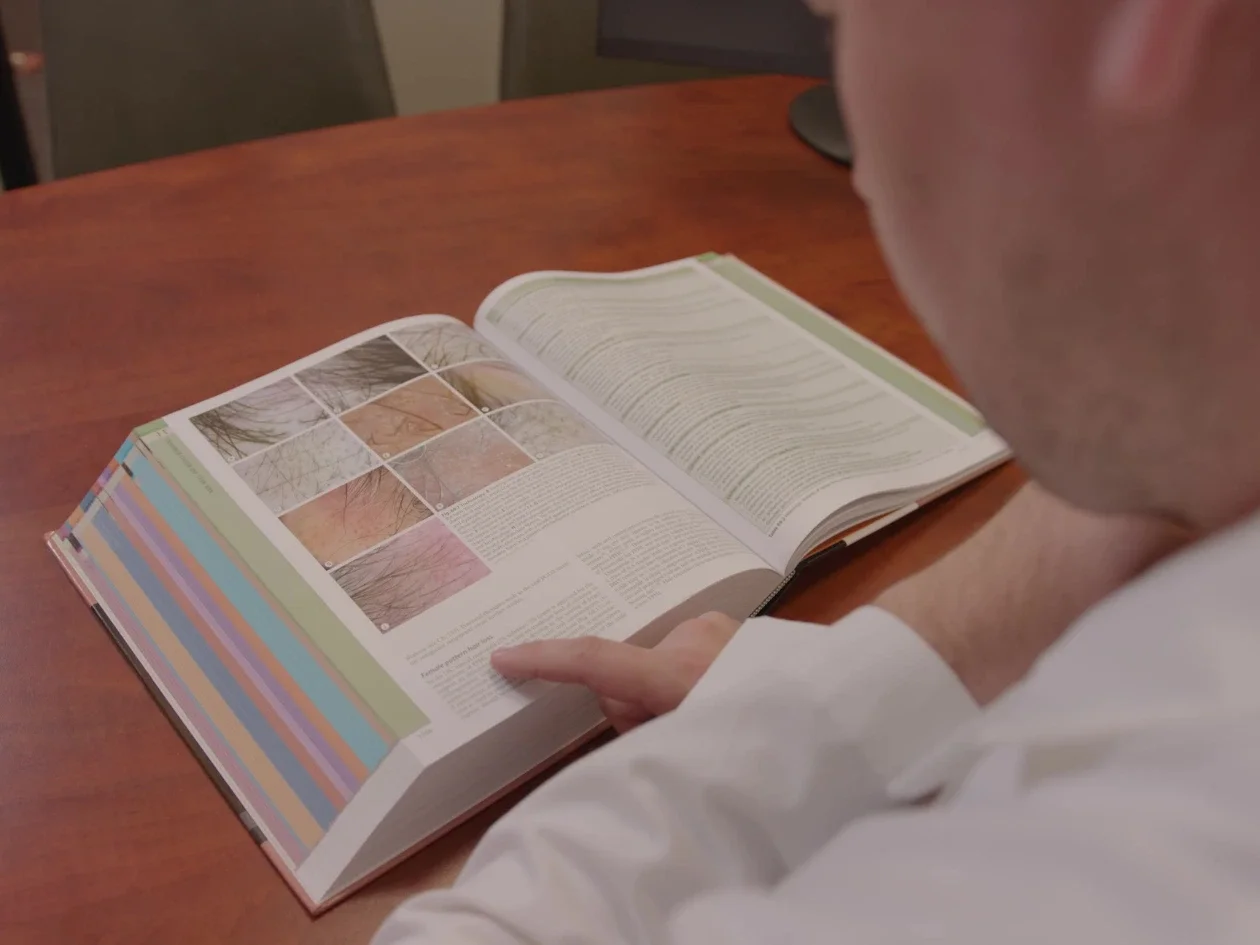
2. Supplements: Peripheral Tissue and the DHT Myth
After minoxidil failed, we tried what every woman tries: biotin, collagen, saw palmetto, pumpkin seed oil, DHT blockers.
My mother took them religiously for months. Nothing changed.
Here's why supplements fail menopausal women on two fronts:
Problem #1: Your Scalp Is Peripheral Tissue
Your scalp is what scientists call "peripheral tissue" - areas farthest from your heart that naturally get less blood flow and fewer nutrients.
It's why your hands are often called "the dead giveaway of age" - they wrinkle and spot years before your face does.
When you take oral supplements, they travel through your bloodstream. Your vital organs get first priority. Your heart, brain, liver - they take what they need.
By the time those nutrients reach your scalp at the end of the line, there's almost nothing left.
During menopause, this peripheral aging accelerates dramatically. Blood flow decreases even further. Nutrient delivery slows to a crawl.
Your scalp is starving while you're spending $50 a month on supplements that never reach it.
Problem #2: The DHT Blocker Lie
Then there's the DHT theory. Countless supplements claim to block DHT - the hormone supposedly causing your hair loss.
Saw palmetto. Pumpkin seed oil. Even prescription blockers..
Here's what studies actually show: researchers tested the only FDA-approved DHT blocker (fin) on menopausal women for 12 months.
The result? Women continued losing hair. DHT blocking did nothing. Zero improvement in hair count, thickness, or regrowth.
If the only FDA-approved prescription DHT blocker doesn't work in menopausal women, why would a $20 supplement the FDA doesn't even monitor?
My recommendation: I don't recommend oral supplements for menopausal hair loss. They can't reach peripheral tissue effectively, and the DHT-blocking supplements are based on science that doesn't apply to women. Save your money.
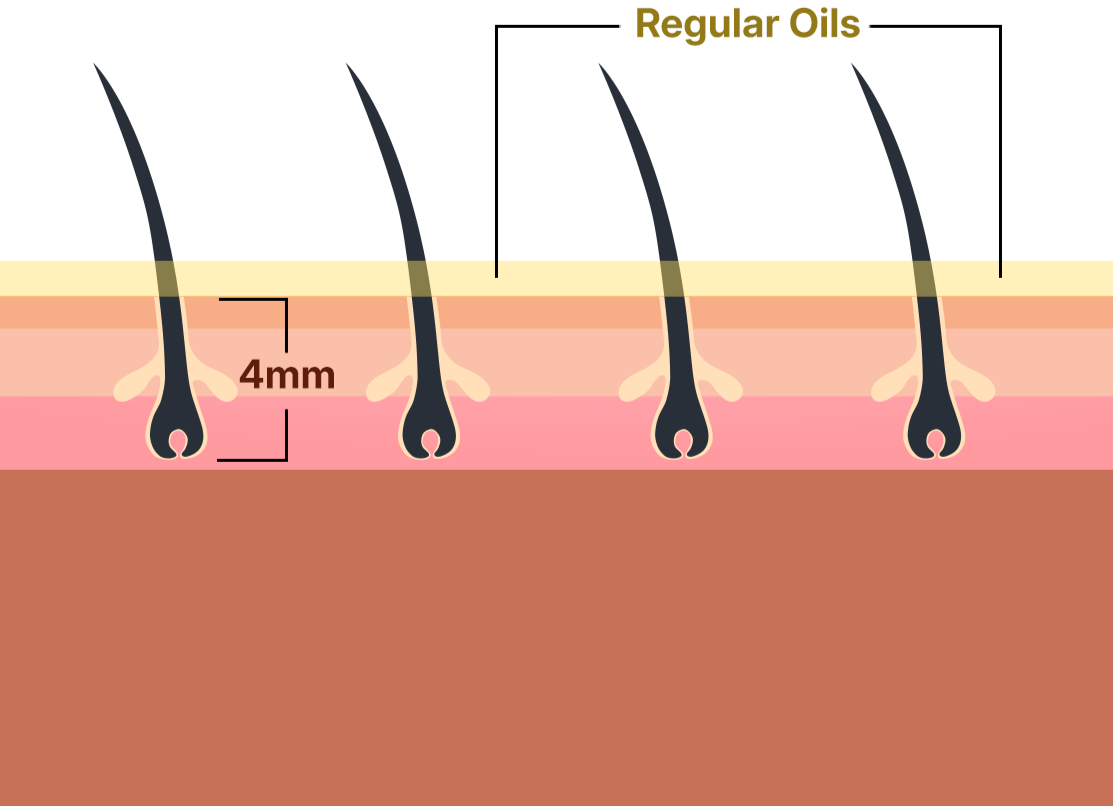
3. Over-the-Counter Hair
Oils: Lack of Penetration
Out of desperation, we tried natural remedies. Rosemary oil. Castor oil. Pumpkin seed oil. All the oils everyone swears by online.
My mother applied them religiously. Her pillowcases were stained. Her hair felt greasy.
But nothing grew back.
Here's the problem with regular hair oils: your scalp has a protective barrier - think of it like plastic wrap designed to keep things out.
Regular oils sit on top of that barrier. They might soften the surface, but they never break through. The active compounds that could help your follicles are stuck on the wrong side of the plastic wrap.
Your follicles are 4mm deep in your scalp. The oils? They're sitting on the surface, then evaporating or washing away in the shower.
My mother was spending hours applying oils that would never reach the follicles where actual growth happens - trapped above the barrier, never penetrating below it.
My recommendation: Traditional hair oils don't work for menopausal hair loss because they can't penetrate deep enough to reach your follicles. Unless an oil has a specialized delivery system that breaks through the scalp barrier, you're just making your pillowcases greasy.
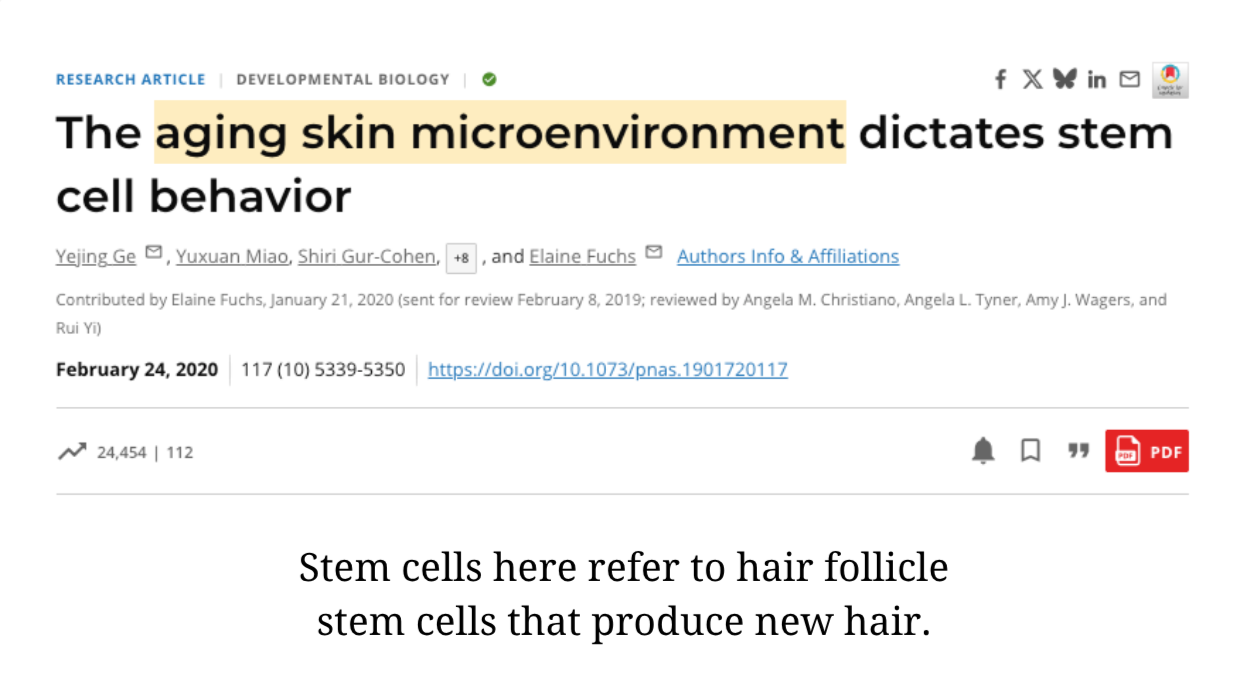
The 2020 Landmark Study
That Changed Everything
Three different treatments. Three different failures. But one pattern I couldn't ignore: they all assumed the follicles were broken.
Minoxidil tried to force them to grow. Supplements tried to feed them. Oils tried to nourish them.
But what if the follicles were fine? What if we were targeting the wrong thing entirely?
I spent nights in Stanford's research library, desperately searching for anything that could explain why healthy follicles would suddenly stop working after menopause.
Then I found it. A study published that same year, 2020, in Proceedings of the National Academy of Sciences.
The timing felt like fate. This research was so new that most dermatologists hadn't even read it yet.
Researchers had done something unprecedented. They took healthy, young hair follicles and transplanted them into aged scalp tissue.
The follicles stopped growing completely. As if someone had flipped a switch.
Then they did the reverse. They took supposedly "dead" follicles from balding areas and transplanted them into young, healthy scalp tissue.
Those dead follicles came back to life. They started producing thick, healthy hair.
This proved something that had never been demonstrated before: it's not about your follicles or your genetics. It's about the tissue environment.
Even perfect follicles can't grow in severely aged scalp tissue.But even "dead" follicles will thrive in young, healthy tissue.
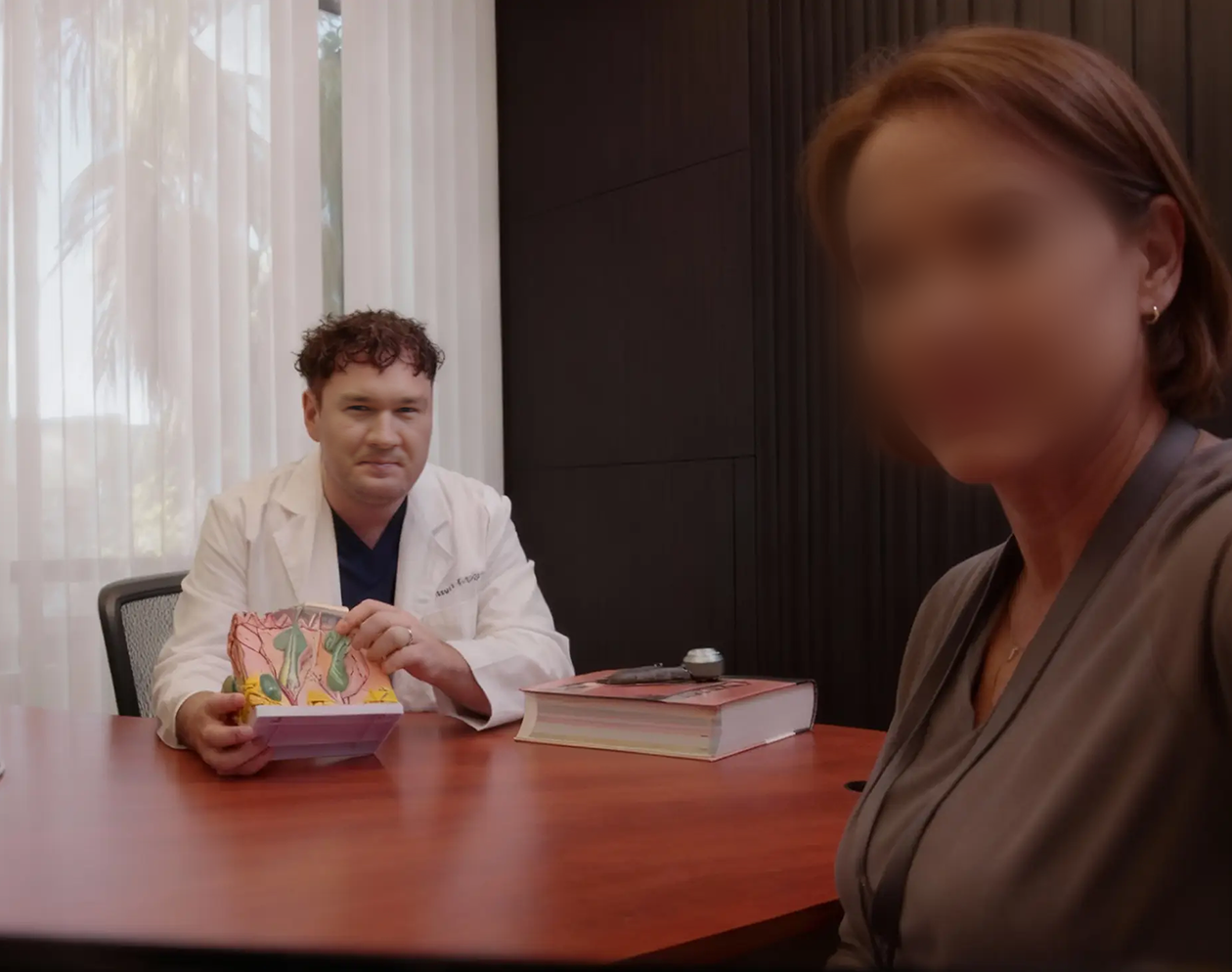
My Mother's Scalp Was 92
Years Old (And She Was 52!)
After reading that study, I immediately wanted to test something.
Using standardized biomarkers for tissue aging, I measured my mother's scalp's biological age.
The result made my stomach drop: 92 years old.
My mother was 52. Her scalp tissue had aged 40 years beyond her chronological age.
"How is that even possible?" she asked, devastated.
This is what I explained to her - and what every menopausal woman needs to understand:
Your scalp is peripheral tissue - the farthest point from your heart. Like your hands, which wrinkle and spot years before your face does. Last in line for blood flow, last in line for nutrients.
During menopause, three catastrophic changes happen simultaneously:
First, estrogen crashes. Estrogen is what protects your scalp tissue from inflammation and oxidative damage. When it drops, your scalp loses its natural defense system overnight.
Second, blood flow to peripheral tissue decreases dramatically. Your scalp, already last in line, gets even less circulation. Less oxygen. Fewer nutrients. The tissue starts to wither.
Third, collagen production drops by 30%. Collagen is the structural foundation that anchors your hair. Without it, even healthy follicles can't grip the tissue properly.
These three factors combine into what I call "Menoscalp" - catastrophic scalp tissue aging that happens in months, not decades.
Your face might age a year during menopause. Your scalp ages ten years.
That's why my mother's scalp measured 92 when she was only 52.
Think about what you do for your face every night. Cleansers, serums, retinol, vitamin C, moisturizers. Ten minutes of careful anti-aging attention to keep it young.
Your scalp, which ages 10 times faster? Just shampoo and conditioner.
We've been ignoring the most rapidly aging tissue on our entire body.

Creating What the Research Proved Was Needed
Once I understood my mother's scalp had aged 40 years beyond her actual age, everything clicked into place.
Of course minoxidil failed - her 92-year-old scalp couldn't produce the enzyme to activate it.
Of course supplements failed - peripheral tissue that aged can't absorb nutrients properly.
Of course oils failed - they sat on the surface of 92-year-old tissue that had lost the ability to let anything penetrate.
But here's what gave me hope: that 2020 PNAS study proved even "dead" follicles could grow in young tissue.
If I could reverse her scalp's biological age - take it from 92 back down to something younger - her follicles would grow again.
This was a complete paradigm shift. For decades, we'd been treating follicles - trying to stimulate them, supplement them, force them to grow.
But the follicles were fine. The aging scalp tissue was the problem.
And because this research was brand new - published the same year my mother was losing her hair - no one had developed a solution for it yet.
No treatment existed that actually reversed scalp tissue aging. Minoxidil, supplements, oils - they were all designed based on the old understanding.
I realized I had an opportunity. Armed with this breakthrough research and access to Stanford's resources, I could pioneer something entirely new.
A treatment that didn't just address symptoms, but reversed the actual cause: catastrophic scalp tissue aging during menopause.

The First DIY Routine With
Transplant-Level Results
I went into the lab with a clear mission: create the first solution designed specifically to reverse scalp tissue aging, not just stimulate follicles.
I started with Redensyl, a breakthrough molecule that reactivates dormant follicle stem cells. Clinical trials showed 214% increase in growth - almost double what minoxidil achieved.
But more importantly, it was growing hair that stayed rooted. Thick, strong hair from root to tip.
Then I added Capixyl, which reduced scalp inflammation by 48% while increasing density by 79%. Not just more hair - dense, robust hair that felt completely different.
Procapil strengthened hair anchoring at the root. What good is growing thick hair in restored tissue if it just falls out?
When these three compounds were combined in trials, they outperformed 5% minoxidil by 81% - with zero side effects.
But for a 92-year-old scalp like my mother's, I needed a comprehensive approach to reverse decades of aging.
I added caffeine for blood flow to starved follicles. Rosemary extract to reduce inflammation. Saw palmetto to block DHT at the scalp level. Turmeric to heal years of damage. Pine bark for antioxidant protection. Amla for strengthening. Pumpkin seed for nourishment. Vitamin C for collagen production.
Thirteen powerful compounds at full clinical strength. Together, these compounds produced over 10,200 new hairs in 12 weeks. That's more than a $15,000 hair transplant delivers.
Most brands use 1-2 ingredients at minimum doses. When you're pioneering a solution for your own mother, you don't compromise.

The Stanford Advantage: Patented Liposomal Delivery
Remember what happened with the oils? They couldn't penetrate past the scalp's protective barrier.
All these powerful ingredients meant nothing if they couldn't reach the follicles 4mm deep where growth actually happens.
This is where being at Stanford gave me an advantage. I developed a patent-pending liposomal delivery system - tiny vesicles made of the same material as your cell membranes that fuse with your skin cells and smuggle the ingredients past that protective barrier.
This is the only formula on the market that successfully delivers active compounds this deep into scalp tissue.
Our Prevention Serum delivers 14.5 milligrams of active ingredients - 580% better absorption than standard 5% minoxidil.
Our Treatment Serum delivers 4.3 milligrams of concentrated actives - 172% better than minoxidil.
While minoxidil struggles to deliver just 2.5 milligrams, mostly sitting on the surface and washing away.
This wasn't just an improvement. It was a complete breakthrough in delivery that had never been achieved before.

My Mother's Transformation
I gave my mother the dual-action system I'd developed. Two serums she'd apply right after her nighttime face routine.
It took 50 seconds total.
I explained it to her: "Mom, your follicles aren't dead. That 2020 study proved it. They're suffocating in 92-year-old tissue. These serums will reverse the aging itself - not just force temporary growth like minoxidil tried to do. We're going to make your scalp younger."
She was skeptical. Every woman in her family had gone bald after menopause. Every treatment had failed her. Why would this be different?
But she trusted me. She started that night.
Within two weeks, something remarkable happened.
Her shedding stopped completely. Her shower drain stayed clear for the first time in months. No more handfuls of hair when she washed it.
"James, I think something's actually working," she called to tell me, her voice shaking with hope.
By week six, tiny baby hairs started sprouting along her hairline and part.
These weren't the weak, wispy strands she'd been growing before. These were thick, robust hairs pushing through with real strength.
Proof that her "dead" follicles weren't dead at all - just waiting for tissue young enough to support them.
By month three, her hairdresser - who'd been cutting her hair for over a decade - was stunned.
"What are you doing differently?" she kept asking, running her fingers through my mother's hair. "The texture has completely changed. Your hair feels like rope - in the best way possible. It's so strong and thick."
When I measured my mother's scalp tissue age again at month three, it had dropped from 92 to 68. Still older than her chronological age, but decades younger than when we started.
That tissue age reversal was the key to everything.
My mother had thicker, fuller hair than she'd had in her 30s. Not because we forced her follicles to grow in hostile tissue. But because we reversed the tissue aging first, then let her healthy follicles do what they were designed to do.
Today at 58, my mother has hair so full and dense that people regularly ask if she's wearing extensions.
She's confident again. Taking photos again. Going out with friends again.
She's herself again.
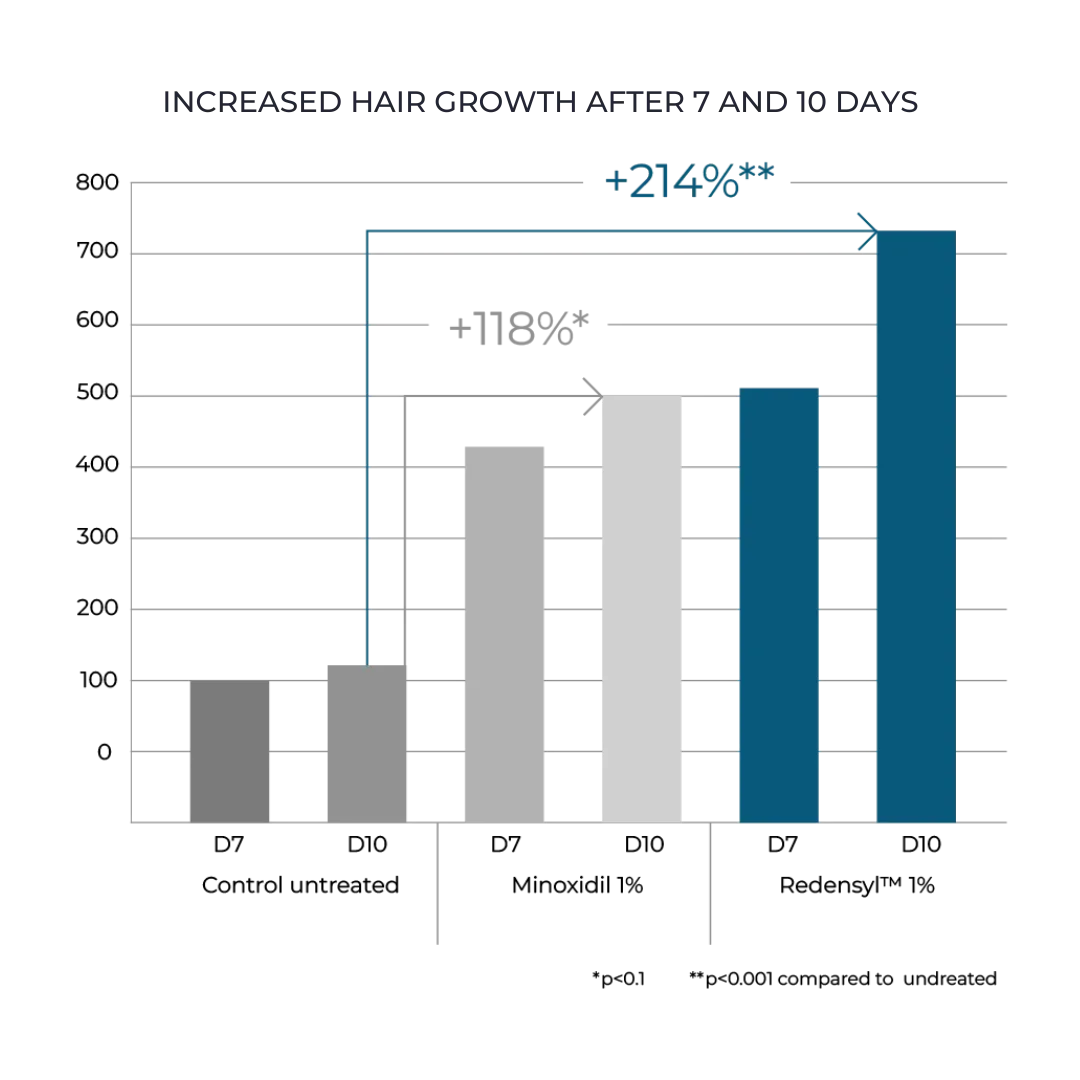
The Clinical Results
Word spread from my mother to her friends. Then to my patients. Then across the country.
Word spread from my mother to her friends. Then to my patients. Then across the country.
The clinical data on these ingredients was remarkable:
Women in studies grew over 10,200 new hairs in just 12 weeks with the key active ingredients. More than a $15,000 transplant delivers.
The combination of Redensyl, Capixyl, and Procapil outperformed minoxidil by 81% in clinical trials without any of the shedding, itching, or heart palpitations.
Zero adverse effects reported across all clinical studies of these compounds.
Today, over 40,000 women have experienced the same transformation my mother did.
The system won the Marie Claire 2024 Award for Best Medical-Grade Scalp Solution. Over 700 physicians now recommend it to their patients.
Seeing how this approach helped women - and how innovative reversing scalp tissue aging was compared to traditional treatments - we decided to offer a full 90-day money-back guarantee.
This means you can experience the same 12-week results observed in the clinical studies, completely risk-free. Use the entire system. If you don't see the transformation, you get your money back. No questions asked.
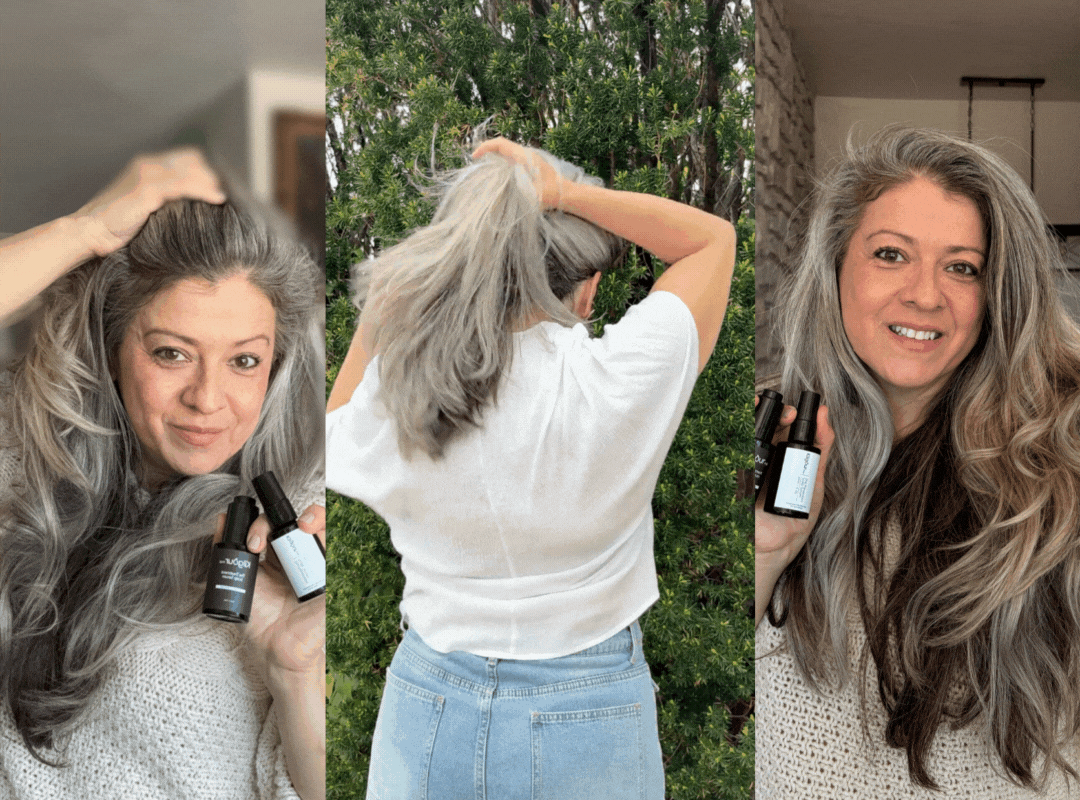
What Others Are Saying
As word spread and more women started using the system, I began hearing stories that mirrored my mother's transformation.
Varenya had tried everything before finding us. "I have tried 4-5 other serum products for hair growth, including vegamour, act + acre, divi, nutrafol, nulastin and dioxin," she told me. "Of all these products, kilgourmd has been the best in terms of real results."
After three months of consistency, she reported major regrowth at her temples and midline part - the exact areas where scalp tissue ages fastest during menopause.
Rachel noticed something different within weeks. "Thin hairs started to grow in where I applied the serum," she shared. "My hair feeling healthier and thicker overall."
But it was Stacey's hairdresser who confirmed what I'd seen with my own mother.
After 15 years of cutting Stacey's hair, her stylist was genuinely surprised by the new growth. The kind of reaction you can't fake - when someone who sees your hair every few months notices dramatic change.
These weren't isolated cases. They were the pattern I'd been hoping to see: scalp tissue aging reversal leading to real, sustainable hair regrowth.
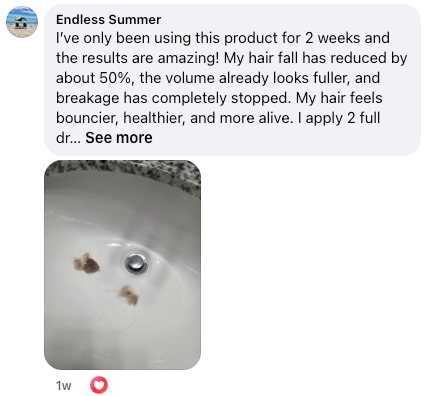
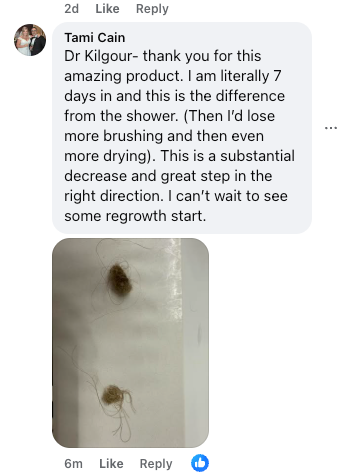
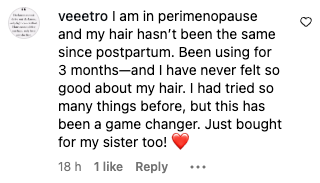
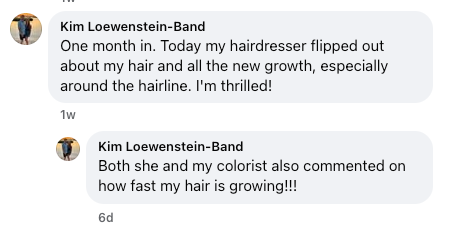
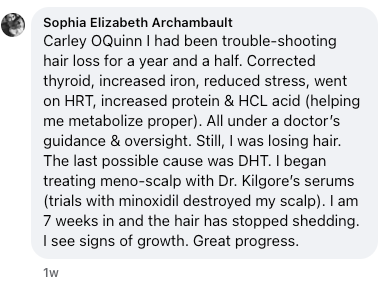
Get Your Exclusive
Reader's Discount
After transforming my mother's hair and helping thousands of women through my practice at Stanford, I wanted to make this approach available to everyone who couldn't see me in person.
Today, over 700 US clinicians recommend this routine to their patients dealing with menopausal hair loss.
✅ 90-Day "Bottom of the Bottle" Guarantee – Use the entire system for three months, and if you don't see results, we’ll refund your order.
✅ Zero-Hassle Refund Process – No complicated return procedures, no partial refunds, no questions asked. If you're not completely satisfied for ANY reason, you get your money back – period.
SELL-OUT RISK: HIGH
Free Shipping
The Choice Is Yours
You could continue using treatments that were never designed for menopausal women.
Minoxidil that 70% of women can't activate. Supplements that never reach your scalp. Oils that sit on the surface.
Or you could try the approach that reversed my mother's 92-year-old scalp back to 68, stopped her shedding in weeks, and gave her thicker hair than she had in her 30s.
The system is remarkably simple to use. The entire routine takes just 50 seconds after your regular skincare. No doctor visits, no messy applications, no complicated steps.
It also comes with a full 90-day money-back guarantee, meaning you can try it for the full study period that beat a hair transplant, and if you don't like it, you get your money back.
SELL-OUT RISK: HIGH
Free Shipping

PostMenoAndDone __8 hours ago
This article finally explains why my dermatologist kept pushing minoxidil and it did absolutely nothing for me except burn my scalp. I had no idea about that enzyme thing - 70% of us can't even activate it?? Why don't they tell us this before prescribing it? I wasted 6 months and $200. Going to order this and try it.
8 likes__Reply
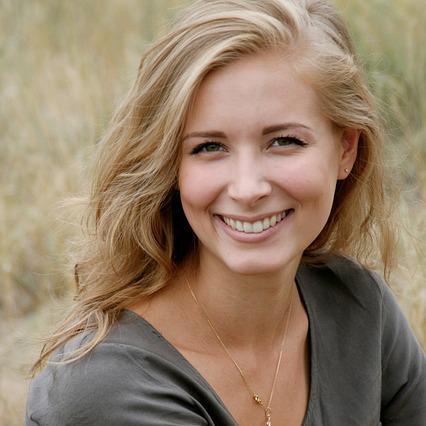
someone_else __3 hours ago
The part about scalp tissue aging 10x faster than your face during menopause hit me hard. I spend $300 a month on facial skincare and give my scalp... shampoo. That's insane when you think about it. My dermatologist never mentioned any of this, just told me it's 'part of menopause' and to wait it out.
5 likes__Reply
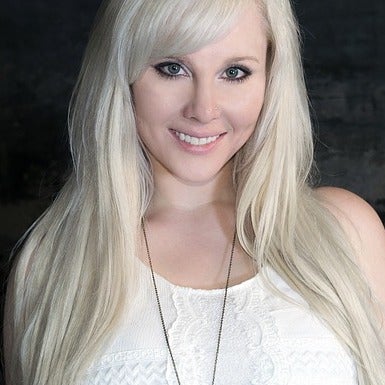
Eloise F.__4 hours ago
I showed this article to my doctor and she actually confirmed the 2020 PNAS study is real. She said most dermatologists just haven't caught up to the research yet. She told me to try it and report back. Ordering now.
2 likes__Reply

James V. __6 hours ago
My wife has been crying in the bathroom for months. Every treatment her doctor gave her failed. I'm sending her this article right now. The science about follicles not being dead but just in aged tissue makes so much sense. ❤️
__Reply

Samantha A. __54 minutes ago
The supplement section explained why I wasted a year on biotin and collagen. 'Peripheral tissue' - I never knew our scalp was last in line for nutrients. That's why oral supplements don't work. This is the first thing I've read that actually explains WHY things fail instead of just saying 'try this next.' Just ordered both serums.
__Reply
SELL-OUT RISK: HIGH
Free Shipping

© 2025. All rights reserved. ADVERTORIAL. Use of this site constitutes acceptance of our Terms & Conditions and Privacy Policy. The material on this site may not be reproduced, distributed, transmitted, cached, or otherwise used without the prior written permission of MenopausalHairLoss.com.
The information provided on this website, including any information related to products mentioned, is for informational purposes only and is not intended to diagnose, treat, cure, or prevent any disease, nor is it intended to affect the structure or function of the skin or body. Individual results may vary. This information does not constitute medical advice and should not be relied upon as a
©Funnelish, All rights reserved.
